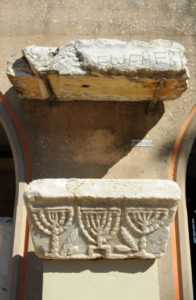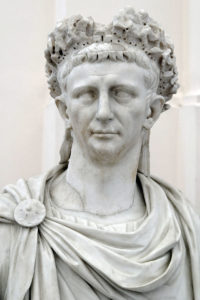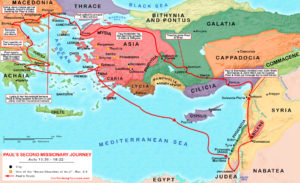Μετὰ ταῦτα χωρισθεὶς ἐκ τῶν Ἀθηνῶν ἦλθεν εἰς Κόρινθον. [2] καὶ εὑρών τινα Ἰουδαῖον ὀνόματι Ἀκύλαν, Ποντικὸν τῷ γένει, προσφάτως ἐληλυθότα ἀπὸ τῆς Ἰταλίας καὶ Πρίσκιλλαν γυναῖκα αὐτοῦ διὰ τὸ διατεταχέναι Κλαύδιον χωρίζεσθαι πάντας τοὺς Ἰουδαίους ἀπὸ τῆς Ῥώμης, προσῆλθεν αὐτοῖς, [3] καὶ διὰ τὸ ὁμότεχνον εἶναι ἔμενεν παρ᾽ αὐτοῖς καὶ ἠργάζοντο, ἦσαν γὰρ σκηνοποιοὶ τῇ τέχνῃ. διελέγετο δὲ ἐν τῇ συναγωγῇ κατὰ πᾶν σάββατον, [4] ἔπειθέν τε Ἰουδαίους καὶ Ἕλληνας. [5] Ὡς δὲ κατῆλθον ἀπὸ τῆς Μακεδονίας ὅ τε Σίλας καὶ ὁ Τιμόθεος, συνείχετο τῷ λόγῳ ὁ Παῦλος, διαμαρτυρόμενος τοῖς Ἰουδαίοις εἶναι τὸν Χριστὸν Ἰησοῦν. [6] ἀντιτασσομένων δὲ αὐτῶν καὶ βλασφημούντων, ἐκτιναξάμενος τὰ ἱμάτια εἶπεν πρὸς αὐτούς, “Τὸ αἷμα ὑμῶν ἐπὶ τὴν κεφαλὴν ὑμῶν: καθαρὸς ἐγώ: ἀπὸ τοῦ νῦν εἰς τὰ ἔθνη πορεύσομαι.”
- Map
- Pre Reading
- Post Reading
- Culture Essay
When Paul is unsuccessful at Athens, he travels west to Corinth, the Roman capital of the province Achaea. There he meets Aquila and Priscilla, refugees from Rome. According to the Roman historian Suetonius (Life of Claudius 25), the emperor Claudius (41-54) “expelled Jews from Rome who were continuously making an uproar at Rome with Chrestos as the instigator.” Suetonius wrote Chrestos, a common name for a slave meaning “good,” but it would have been pronounced as Christos due to a linguistic process called itacism, the process whereby certain vowel sounds took on the same “i” sound as an iota. Therefore, the phrase impulsore Chresto is usually interpreted as a controversy in Rome between Jews and Jewish Christians over the Christ, the “anointed one.” Various dates for this action during Claudius’ reign have been proposed, but no consensus has been reached. Most commentators place Paul’s first visit to Corinth around 50-52 CE.
Paul has two companions on his second missionary journey, Silas and Timothy. Silas is first mentioned at the Jerusalem Council (Acts 15: 22). He is called a leader (15: 22) and a prophet (15: 32). Timothy first joins Paul and Silas on their journey in Lystra (16: 1) at the recommendation of the church elders at Iconium and Lystra in the Roman province of Galatia. He was circumcised by Paul since his mother was a Jewish convert.
Priscilla and Aquila are mentioned a number of times in Acts and Paul’s letters, always as a couple: Acts 18: 18, 26; 1 Cor. 16: 19; Rom. 16: 3-5; and 2 Tim. 4:19.
Why do both Luke and Paul regularly mention Prisca’s name first (1 Cor. 16:19 is the exception)? Is this because they have different status (e.g., free vs. freed slave) or prominence within the buddding Christian community?
What do we learn about their social class? and Paul’s?
How do Priscilla and Aquila demonstrate commitment (discipleship, if you will) within this new religious community?
What might have caused Claudius to expel Jews such as Aquila from Rome?
By convention, readers of Acts divide Paul’s missionary activity into three journeys. The first journey takes place before the Jerusalem Council (Acts 13:3-14:28) and begins when the church at Antioch in Syria commissioned Barnabas and Paul to spread the “good news” of the risen Christ to areas on the island of Cyprus, then to Pamphilia in southwestern Turkey and southern Galatia (central Turkey).
The second journey (Acts 15:41-18:22) takes place after the Council and once again sets out from Antioch, travels through Galatia to Thrace and Macedonia. After facing imprisonment at Philippi, controversy in Thessalonica, and little interest in Athens, Paul must have been glad to be welcomed at Corinth for a year and a half. The second missionary journey concludes when Paul sails from Cenchreae to Ephesus.
On the third missionary journey (Acts 18:23-20:38), Paul heads from Antioch to Ephesus where Paul stays for three years, preaching and teaching for two of those years in the hall of Tyrannus. After the silversmiths, upset at the loss of business in crafting and selling idols, lead a tumultuous protest in the theater, Paul departs for Macedonia and Achaea to check in on the churches established during the second journey. While he is at Corinth, he writes his letter to the Romans. After several months in Corinth, he returns north through Macedonia where he writes his second letter to the Corinthians. The journey ends with stops in Miletus, Phoenicia, and Jerusalem.


